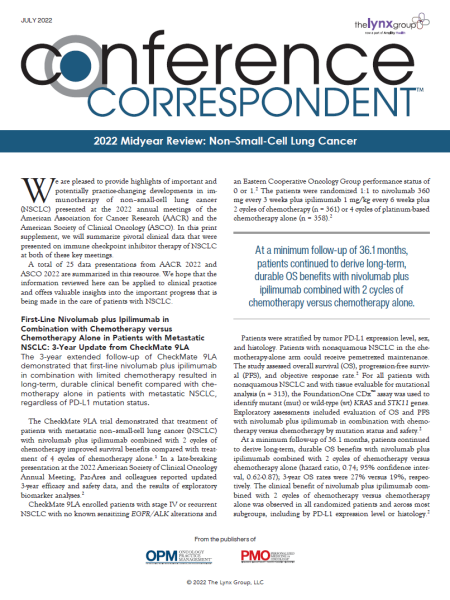Co-inhibition of TIGIT and PD-L1 signaling enhances clinical outcomes in chemoimmunotherapy-naïve patients with PD-L1–positive advanced NSCLC.
T-cell immunoreceptor with immunoglobulin and immunoreceptor tyrosine-based inhibition motif domains (TIGIT) is a recent immune checkpoint to be investigated as an immunotherapeutic target. TIGIT is an inhibitory immune checkpoint that is present on activated T-cells and natural killer T-cells in multiple cancers, including NSCLC.1
In a phase 1 study called GO30103, co-inhibition of TIGIT and PD-L1 signaling with tiragolumab plus atezolizumab (Tecentriq) in chemoimmunotherapy-naïve PD-L1–positive NSCLC improved ORRs compared with historical ORR data with PD-L1 and PD-1 inhibitors.2 Researchers conducted a randomized phase 2 trial, called CITYSCAPE, to confirm the efficacy and safety of tiragolumab plus atezolizumab compared with placebo plus atezolizumab in frontline NSCLC.2
CITYSCAPE is a prospective, randomized, double-blind, placebo-controlled trial. Patients could enroll in the trial if they had an Eastern Cooperative Oncology Group performance status of 0 or 1, NSCLC with squamous or nonsquamous histology, no previous systemic therapy for locally advanced unresectable or metastatic disease, and PD-L1 expression as assessed by 22C3 immunohistochemistry by local or central assay. Patients with ALK or EGFR mutations were excluded from the trial.2
Patients were randomized to receive tiragolumab (600 mg intravenous [IV]) plus atezolizumab (1200 mg IV) or placebo plus atezolizumab (1200 mg IV) on day 1 of every 3-week cycle.2 Stratification factors included PD-L1 status (tumor proportion score [TPS] ≥50% vs TPS 1%-49%), histology, and tobacco history.2 Co-primary end points were investigator-assessed ORR and PFS. Additional end points were duration of response, OS, and safety.2
A total of 135 patients were randomized to placebo plus atezolizumab (N = 68) or tiragolumab plus atezolizumab (N = 67).2 More than half of patients in both study arms had PD-L1 TPS 1% to 49% (57% each) and nonsquamous histology (60% vs 59%, respectively).2 At the time of primary analysis, tiragolumab plus atezolizumab resulted in a 43% reduction in the risk for disease progression or death compared with atezolizumab plus placebo (stratified HR, 0.57; 95% CI, 0.37-0.90).2 With an additional 6 months of follow-up, improvement in PFS was maintained with medians of 5.6 months versus 3.9 months, respectively (stratified HR, 0.58; 95% CI, 0.38-0.89).2 At the primary analysis, ORR in the tiragolumab plus atezolizumab arm was almost double that of the placebo plus atezolizumab arm: 31% versus 16%, respectively.2 Updated analysis confirmed the ORR in both groups: 37% and 21%, respectively.2
In an exploratory analysis of 58 patients with high PD-L1 expression (TPS ≥50%), there was a 70% reduction in the risk for disease progression or death with tiragolumab plus atezolizumab versus placebo plus atezolizumab (stratified HR, 0.30; 95% CI, 0.15-0.61).2 Median PFS for patients with high PD-L1 expression was not evaluable with tiragolumab plus atezolizumab compared with 4.1 months with placebo plus atezolizumab.2 ORRs for patients with high PD-L1 expression were 66% and 24%, respectively.2
In the safety population (tiragolumab plus atezolizumab, placebo plus atezolizumab), any-cause AEs occurred in 99% and 96% of patients, respectively.2 Grade ≥3 AEs occurred in 48% of patients receiving tiragolumab plus atezolizumab and 44% of patients receiving placebo plus atezolizumab.2 AEs that led to treatment withdrawal occurred in 9% and 10% of patients, respectively.2
Researchers concluded that treatment with the anti-TIGIT antibody tiragolumab plus atezolizumab showed clinically meaningful improvements in ORR and PFS compared with placebo plus atezolizumab in chemoimmunotherapy-naïve patients with PD-L1–positive NSCLC. The safety profile of tiragolumab plus atezolizumab was similar to placebo plus atezolizumab.2
References
1. Harjunpää H, Guillerey C. TIGIT as an emerging immune checkpoint. Clin Exper Immunol. 2019;200:108-119.
2. Rodriguez-Abreu D, Johnson ML, Hussein MA, et al. Primary analysis of a randomized, double-blind, phase II study of the anti-TIGIT antibody tiragolumab (tira) plus atezolizumab (atezo) versus placebo plus atezo as first-line (1L) treatment in patients with PD-L1-selected NSCLC (CITYSCAPE). J Clin Oncol. 2020;38(15_suppl). Abstract 9503.

